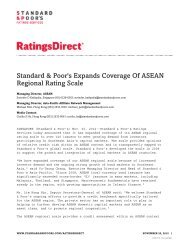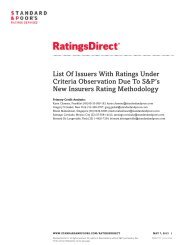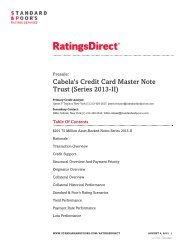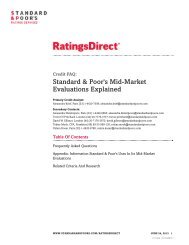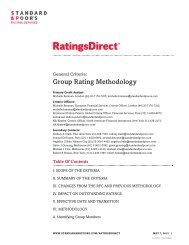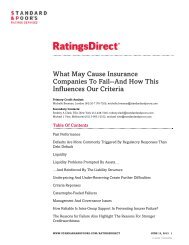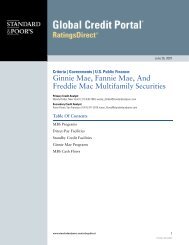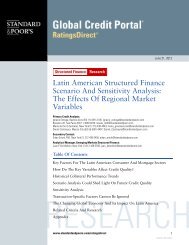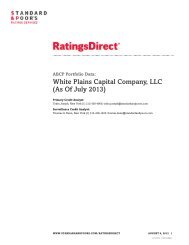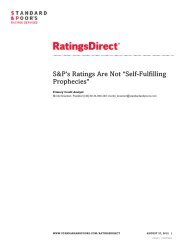Principles Of Credit Ratings - Standard & Poor's
Principles Of Credit Ratings - Standard & Poor's
Principles Of Credit Ratings - Standard & Poor's
Create successful ePaper yourself
Turn your PDF publications into a flip-book with our unique Google optimized e-Paper software.
General Criteria: <strong>Principles</strong> <strong>Of</strong> <strong>Credit</strong> <strong>Ratings</strong>• Operational and administrative risks; and• Counterparty risk.7. The analytic framework for corporate and government ratings includes three key areas:• <strong>Credit</strong>worthiness before external support;• External support; and• Analysis of specific instruments.IMPACT ON OUTSTANDING RATINGS8. This criteria update does not cause changes to any outstanding ratings.EFFECTIVE DATE AND TRANSITION9. These criteria are effective immediately for all new and outstanding ratings.FUNDAMENTAL PRINCIPLES OF STRUCTURED FINANCE RATINGS ANDCRITERIA<strong>Credit</strong> Quality <strong>Of</strong> The Securitized Assets10. In most securitization transactions, the first key step in analyzing the credit quality of the securitized assets isdetermining the amount of credit support necessary, in our opinion, to maintain a rating at the 'AAA' level. Thatdetermination is equivalent to estimating the amount of losses that the assets would suffer under conditions ofextreme stress. The estimation can include reference to historical studies of the subject asset class or, when suchstudies are not available and as we deem appropriate, comparison or benchmarking relative to asset classes forwhich such studies do exist.11. For some asset classes, the estimation may proceed in stages: We might separately estimate asset default frequenciesand loss severities under extreme stress conditions and then combine those components to form the overall lossestimate. Similarly, for some asset classes, the estimation may use generalizations based on historical studies, such asthe notion that losses under extreme stress conditions can be estimated as a multiple of expected losses, with themultiple potentially varying for different asset classes.12. For some asset classes, <strong>Standard</strong> & <strong>Poor's</strong> defines an archetypical asset pool and uses it as a comparison benchmarkfor gauging the estimated losses under extreme stress for pools underlying actual transactions in such asset classes.In some cases, the maximum rating for the highest rated security may be below 'AAA' based on our assessment offactors such as country risk, or transfer and convertibility risk, and we would adjust the analysis accordingly.13. In many securitization transactions, a key step in analyzing the credit quality of the securitized assets is estimatingthe level of expected losses. The level of expected losses generally corresponds to the amount of credit enhancementassociated with the 'B' rating level. Estimation of expected losses generally uses the recent performance of similarassets as a guide. The estimation may include adjustments based on our assessment of current trends, as well asevolving market practices.14. Interpolation is one of the methods we may use when we analyze the amount of credit enhancement associated withwww.standardandpoors.com/ratingsdirect 3916650 | 300323561




